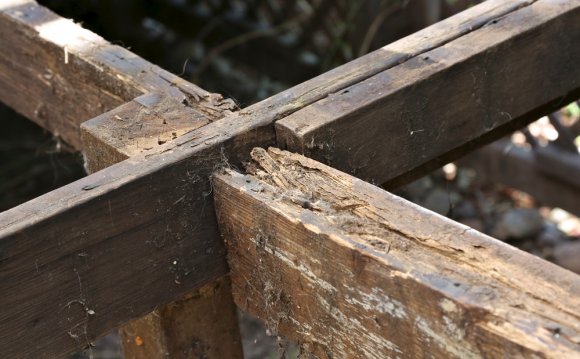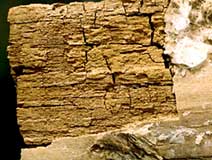
|
Damage may resemble ant or termite damageDry rot is often confused with carpenter ant or termite damage. Carpenter ant damage (see What are Carpenter Ants?) is distinguished by the removal of wood and formation of clean cavities where the carpenter ants live. Subterranean termite damage is similar to dry rot in overall appearance but the presence of live termites, termite galleries and generally wetter wood will usually separate the two conditions (see What are Subterranean Termites?). |
Preventing dry rot damageThe most important way to prevent dry rot damage is to reduce or eliminate excess moisture. This may be as simple as repairing a leaky pipe or as complicated as stopping water infiltration through a basement foundation. A common cause of dry rot and termite damage is wood in contact with soil as occurs, for example, with a failed foundation. If moisture cannot be controlled, or if the dry rot fungus as gained a foot-hold, then wood should be treated to inhibit the growth of the fungus (see below). Boric acid, or borate, is an excellent fungicide (a pesticide that kills fungi) against the dry rot fungus. Borate also prevents insect damage. Wood can be treated during construction, during repair, or as a remedial treatment to stop an active infestation. |
Borate wood preservatives are generally applied as liquids with some type of sprayer. Because borates are water soluble they should not be used where liquid water is present. In wet situations use fused borate instead because it is made for exterior applications. Fused borate is often used to protect log ends in log homes (see Protecting Log Homes From Insects and Dry Rot) and wood utility poles against dry rot. |
Treating & preventing dry rotTreating or preventing dry rot is a three step process. Step 1 is to locate and stop the source of the moisture. Step 2 is to replace any damaged wood that has become structurally weakened. Step 3 is to treat new and existing wood with a borate wood preservative to prevent growth of the dry rot fungus and kill any fungus already in the wood. Borate wood preservative is available as a dry powder or a glycol-based liquid concentrate. The powder form is generally less expensive but there's some evidence that glycol improves the absorption of borate into the wood fibers. One popular liquid borate product that is specifically made to protect wood from dry rot is called Bora Care (see Using Bora Care To Protect Wood From Dry Rot) and one of the powder forms is called TimBor (see Using TimBor to Treat Wood Against Dry Rot). After mixing with water either product can applied to dry, unfinished wood with a garden sprayer or paint roller. Some applications require two coats (see label instructions) and a colored dye such as Turf Mark (tm) is useful to mark treated areas. Neither TimBor nor Bora Care are generally available in stores but can be purchased here (DoMyOwnPestControl) as well. Related Articles |
'Bugs Needs Your Support! If our information is useful help us maintain and grow 'Bugs. Visit our Support Page or shop at Amazon, one of our favorite affiliates. Amazon is not just books and Kindles, they even have bug stuff! |
Don't forget to bookmark us for next time - press ctrl-D in most browsers. |
Mission: To provide accurate, up-to-date and unbiased information for solving common insect and mite problems around your home, business and landscape using least-toxic methods , email: [email protected] |
Copyright © 2004- |










